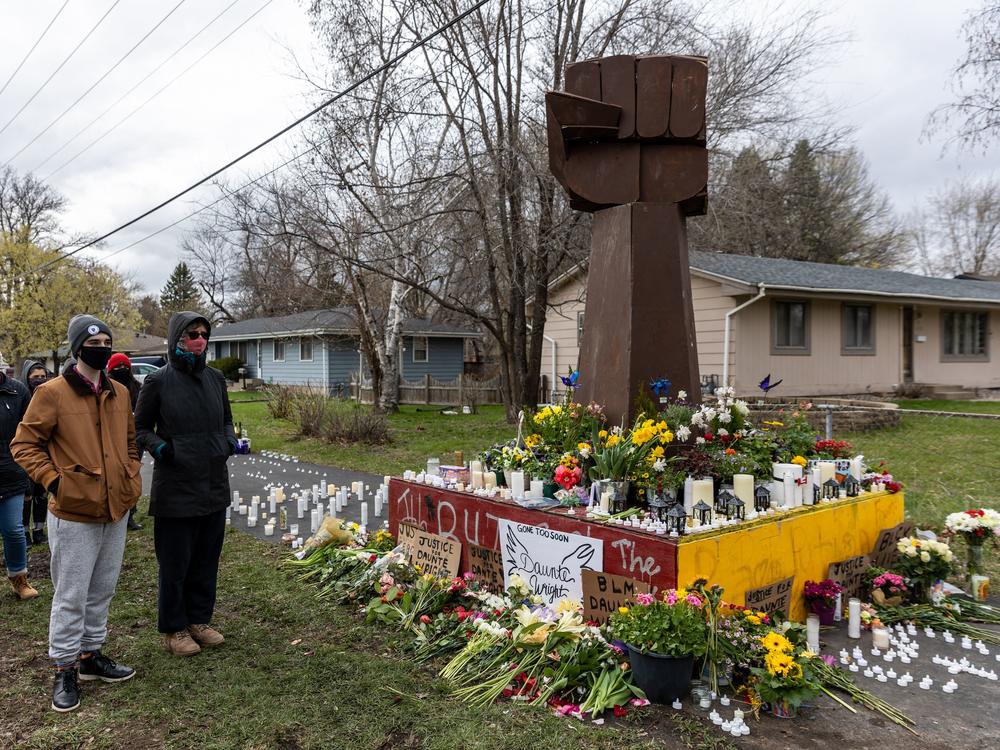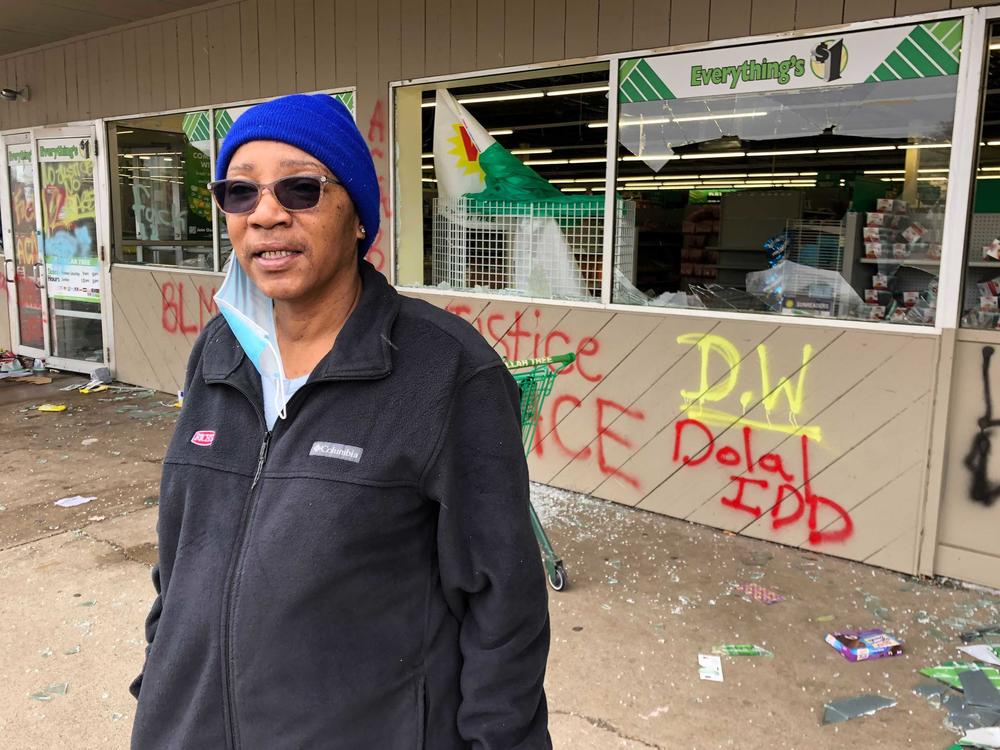Section Branding
Header Content
Brooklyn Center, Minnesota's Most Diverse City, Is In The Spotlight After Shooting
Primary Content
Never has so much attention focused on these quiet, leafy eight square miles along the Mississippi River.
Brooklyn Center, Minn., a small inner-ring suburb of modest postwar houses and apartment buildings, is the latest community to feel the heat of the national spotlight in the days since the death of Daunte Wright, the 20-year-old Black man shot during a traffic stop by a Brooklyn Center police officer who officials say mistook her handgun for her Taser.
Affordable home prices and easy commutes — no more than 20 minutes to drive to the downtowns of Minneapolis or St. Paul — have long made Brooklyn Center attractive to middle-class families.
In the last 25 years, rapid demographic change has come to this city of just 30,000 people. The exodus of jobs, decline in median income, and rise in poverty that Brooklyn Center has seen in that time would be challenges for any small suburb. But residents say Brooklyn Center's problems are compounded by a city administration and police force that no longer look like the communities that live here.
"Places like this, when they go through racial and social change, they have a hard time rebalancing themselves," said University of Minnesota law professor Myron Orfield.
Central cities like Minneapolis, he said, simply have more resources to deal with rapid change. A downtown business district and rich neighborhoods provide reliable tax revenue, and a larger public administration staff can better coordinate assistance from nonprofits and the federal government.
"But when it hits a place like Brooklyn Center, it hits much harder. It's much harder for them to respond," Orfield said.
Like many of America's inner-ring suburbs, Brooklyn Center grew rapidly during the postwar years. The population of the Twin Cities region was booming, and middle-class whites who wanted to leave behind the neighborhoods of North Minneapolis — where the city's Black population was increasingly concentrated — often chose this small suburb just across the city border to the north, Orfield said. From its incorporation in 1966 into the 1990s, Brooklyn Center's residents remained more than 90% white.
Today, Brooklyn Center is the most diverse city in Minnesota. Just 38% of people here say they are white alone, while nearly 30% are Black, according to the most recent numbers from the Census Bureau. The city also contains significant Asian and Latino populations. Almost a quarter are immigrants, many from Southeast Asia or West Africa.
That's "the fastest demographic transition experienced by any Twin Cities community," according to Orfield.
Middle-class white residents, he says, were replaced initially by middle-class Black folks, who themselves left as Brooklyn Center grew more segregated and more poor. The median income, adjusted for inflation, dropped more than 16% from 2000 to 2018. The poverty rate has more than doubled since 2000.
Meanwhile, local government staff and police force have not kept pace with the demographic changes, with many long-serving employees who were hired in the bygone era.
In 2015, the city reported in a survey conducted by the Minneapolis Star-Tribune that its police force was 87% white. That includes the officer who shot Wright, Kim Potter, who was hired in 1995, when the city was still vast majority white.
"We are a very diverse city, but each community is in its own bubble," said state Rep. Samantha Vang, whose district includes Brooklyn Center.
Vang, who is of Hmong descent, says she ran for office in part to inspire more engagement from people from other groups underrepresented in local government.
"The city government has lacked in really engaging the community here," Vang said. "There's still a lot of work that the city needs to do to really reflect that demographic and to really build that bridge."
In 2014, the city elected its first council member of color. Today, two of the four council members are Black, and two are white. Mayor Mike Elliott, who is Black and a Liberian immigrant, became Brooklyn Center's first mayor of color when he was sworn in January 2019.
At a news conference this week, Mayor Elliott said he believed that none of the force's roughly 49 sworn officers live in the city, a dynamic he vowed to work toward changing. (Potter's home is in nearby Champlin, Minn., where 86% of residents are white and the median household income is $33,000 higher than Brooklyn Center.)
"There is a huge importance to having a significant number of your officers living in the community where they serve," Elliott said. "It helps infuse knowledge of the community into policing, and I think that can only help to enhance the work of the officers, and it can only help to make their jobs better or easier."
Daunte Wright is the sixth person killed by police in Brooklyn Center since 2012, according to an analysis by the Minneapolis Star-Tribune. Five of the six were men of color.
Every night since his death April 11, hundreds of protesters have gathered outside the police department on Humboldt Avenue. At least 20 businesses in Brooklyn Center have been damaged or looted in the unrest since Wright's death, including a Dollar Tree across the street from the station.
"It's scary," said Patricia Hardin, an 11-year-resident of Brooklyn Center, who one morning this week had walked the few blocks from her home to survey the damage at the Dollar Tree. "As soon as it gets dark, all you hear is yelling and screaming and helicopters flying."
Hardin, who is Black, said police in Brooklyn Center — and Minnesota more broadly — have a reputation for targeting Black people.
"They have a job to do, but it doesn't mean they need to shoot Black people," she said, expressing skepticism about police officials' explanation that Potter mistook her handgun for her Taser.
In recent days, Brooklyn Center has drawn comparisons to Ferguson, Mo., another inner-ring suburb where rapid resegregation —coupled with a police force of mostly white officers who lived outside the community — created a combustible foundation that exploded when 18-year-old Michael Brown was shot to death by a white police officer in 2014.
But the Twin Cities region stands out in terms of inequality between its white and Black residents. Multiple studies have found that gaps between white people and Black people in the Minneapolis area are among the largest in the country in a variety of socioeconomic measures.
"It's not only George Floyd and Philando Castile and all these shootings. It's also you have some of the largest disparities between whites and Blacks in terms of education, in terms of mortgage lending, in terms of employment," Orfield said.
Samantha Vang, the state representative, says she hopes this can be a moment for change. She has seen community ties starting to form in the last few days, she says, as people encounter each other at memorials and protests and cleanups at the damaged businesses.
"Brooklyn Center is the future face of America. That is what we're going to look like in another decade or so," Vang said. "And so we've got to learn how to live with one another. We've got to learn how to come together."
Copyright 2021 NPR. To see more, visit https://www.npr.org.



